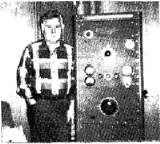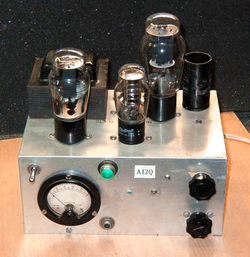
Amateur radio homebrew
Encyclopedia
History

Vacuum tube
In electronics, a vacuum tube, electron tube , or thermionic valve , reduced to simply "tube" or "valve" in everyday parlance, is a device that relies on the flow of electric current through a vacuum...
-based transmitters and receivers which were often housed in their basements, and it was common for a well-built "homebrew rig" to cover all the high frequency
High frequency
High frequency radio frequencies are between 3 and 30 MHz. Also known as the decameter band or decameter wave as the wavelengths range from one to ten decameters . Frequencies immediately below HF are denoted Medium-frequency , and the next higher frequencies are known as Very high frequency...
bands (1.8 to 30 MHz).
Homebrewing was often encouraged by amateur radio publications. In 1950, CQ Amateur Radio
CQ Amateur Radio
CQ Amateur Radio is a magazine for amateur radio enthusiasts. The magazine has a worldwide readership base for its English language edition. A Spanish language edition is published in Spain with some translations of articles from the English language edition and some original European content...
Magazine announced a ‘‘$1000 Cash Prize ‘Home Brew’ Contest’’ and called independently-built equipment ‘‘the type of gear which has helped to make amateur radio our greatest reservoir of technical proficiency.’’ The magazine tried to steer hams back into building by sponsoring such competitions and by publishing more construction plans, saying that homebrewing imparted a powerful technical mastery to hams. In 1958, a CQ
CQ Amateur Radio
CQ Amateur Radio is a magazine for amateur radio enthusiasts. The magazine has a worldwide readership base for its English language edition. A Spanish language edition is published in Spain with some translations of articles from the English language edition and some original European content...
editorial opined that if ham radio lost status as a technical activity, it might also lose the privilege of operating on the public airwaves, saying, ‘‘As our ranks of home constructors thin we also fall to a lower technical level as a group,’’.
In the 1950s and 60s, some hams turned to constructing their stations from kits sold by Heathkit
Heathkit
Heathkits were products of the Heath Company, Benton Harbor, Michigan. Their products included electronic test equipment, high fidelity home audio equipment, television receivers, amateur radio equipment, electronic ignition conversion modules for early model cars with point style ignitions, and...
, Eico
Eico
Eico was a manufacturer of electronics kits located in New York City, New York, USA.-History:EICO was established in New York City in 1945 to manufacture electronic test equipment in kit form...
, EF Johnson, Allied Radio's Knight-Kit
Allied Radio
Allied Radio was an American radio manufacturer and retailer, which sold radio sets, tubes, capacitors , amateur radio equipment, citizen's band radios, miscellaneous communications equipment, electronic kits, and consumer audio systems through retail stores and mail-order.-History:Beginning in...
, World Radio Laboratories
World Radio Laboratories
World Radio Laboratories, WRL, was a major supplier of amateur radio equipment from the 1950s through the 1970s. WRL was located in Council Bluffs, Iowa, and run by Leo Meyerson and his family....
and other suppliers.
Today, only a minority of hams own and operate completely homebrew or kit-built amateur stations. However, there are many new ham radio kit suppliers, and the "art" of homebrewing is alive and thriving.
Practices

Junk box
Junk box is a term used by amateur radio operators to describe a collection of spare parts and old equipment kept to assist in building and repairing their station.-Description and uses:...
electronic components is still possible. Homebrew enthusiasts say that building one's own radio equipment is fun and gives them the satisfaction that comes from mastering electronic knowledge.
QRP homebrew

QRP operation
In amateur radio, QRP operation means transmitting at reduced power levels while aiming to maximize one's effective range while doing so. The term QRP derives from the standard Q code used in radio communications, where "QRP" and "QRP?" are used to request, "Reduce power," and ask "Should I reduce...
ers are ham radio enthusiasts known to use a power output of five watts, sometimes operating with as little as 100 milliwatts or even less. Extremely low power -- 1 watt and below -- is often referred to by hobbyists as QRPp. Commercial transceivers designed to operate at or near QRP power levels have been available for many years, but some QRPers prefer to design and build their own equipment, either from kits or from scratch. Many build miniature transmitters and transceivers into Altoids
Altoids
-Flavors and varieties:-Mints:Altoids mints are available in eight flavors: peppermint, wintergreen, spearmint, cinnamon, ginger, liquorice, crème de menthe and cool honey. "Sugar-Free Smalls", tiny square mints sweetened with sorbitol and sucralose, are also available in peppermint, wintergreen,...
boxes and operate using battery power. Popular QRP kit models include the Elecraft K2 , and those produced by NorCal, Small Wonder Labs, and others. QRP activity can often be heard on 7.030 MHz.
Homebrewing with vacuum tubes

Triode
A triode is an electronic amplification device having three active electrodes. The term most commonly applies to a vacuum tube with three elements: the filament or cathode, the grid, and the plate or anode. The triode vacuum tube was the first electronic amplification device...
Doerle regenerative
Regenerative circuit
The regenerative circuit or "autodyne" allows an electronic signal to be amplified many times by the same vacuum tube or other active component such as a field effect transistor. It consists of an amplifying vacuum tube or transistor with its output connected to its input through a feedback...
receiver and single-tube Hartley
Hartley oscillator
The Hartley oscillator is an electronic oscillator circuit that uses an inductor and a capacitor in parallel to determine the frequency. Invented in 1915 by American engineer Ralph Hartley, the distinguishing feature of the Hartley circuit is that the feedback needed for oscillation is taken from...
, TNT and TPTG transmitters. "Glow" refers to the glow of the vacuum tubes and "bug" to the gear's relatively diminutive size. Generally, any small, home-built tube-type transmitter or receiver may be referred to as a glowbug. The majority of glowbug transmitters are designed to be used in the CW
Continuous wave
A continuous wave or continuous waveform is an electromagnetic wave of constant amplitude and frequency; and in mathematical analysis, of infinite duration. Continuous wave is also the name given to an early method of radio transmission, in which a carrier wave is switched on and off...
radiotelegraphy mode. A number of radio amateurs also build their own tube receivers and AM voice transmitters.
As late as the 1960s, glowbugs were part of many beginner ham stations, and the ARRL Radio Amateur Handbook for those years exhibited a number of such simple, tube-based designs. Today, glowbugs are enjoying a resurgence of interest among QRP
QRP operation
In amateur radio, QRP operation means transmitting at reduced power levels while aiming to maximize one's effective range while doing so. The term QRP derives from the standard Q code used in radio communications, where "QRP" and "QRP?" are used to request, "Reduce power," and ask "Should I reduce...
enthusiasts and others with a penchant for constructing their own equipment. A growing number of hams are "getting back to their roots" by assembling glowbugs on steel chassis, tin cakepans, and wooden boards, and putting them on the air. Amateur radio glowbug enthusiasts can often be heard communicating on the shortwave bands via CW using Morse code
Morse code
Morse code is a method of transmitting textual information as a series of on-off tones, lights, or clicks that can be directly understood by a skilled listener or observer without special equipment...
. A popular frequency to hear glowbug contacts is 3.57950 MHz. Simple oscillators for this frequency can be built with common NTSC color burst oscillator crystals, which operate at 3.579545 MHz.
External links
- Amateur Radio Homebrew, The Open Directory Project
- Homebrew Ham pages by AF4K - Over 280 Ham Radio Homebrewing Articles
- Yahoo rfamplifiers group - A very popular place for those who like to design and build RF Power Amplifiers for use in ham radio
- soldersmoke - A podcast for radio amateurs and homebrewers - A popular weekly podcast which discusses homebrew electronics and radio construction.
- The Novice Special - A simple two-tube transmitter by Gary Johanson, WD4NKA

